
Euphorbia mellifera, the Canary spurge or honey spurge, is a species of flowering plant in the spurge family Euphorbiaceae, native to Madeira and the Canary Islands. It is an evergreen shrub growing to 2 m or more, with narrow leaves up to 20 cm (8 in) long. In spring it produces brown, honey-scented flowers.

Abutilon pictum, syn. Abutilon striatum,(disputed), is a species of flowering plant in the family Malvaceae. It is native to southern Brazil, Argentina, Paraguay and Uruguay. The plant has become naturalised in Central America, and is used in horticulture. Common names include redvein abutilon, red vein Indian mallow, redvein flowering maple, Chinese-lantern and red vein Chinese lanterns.

Genista stenopetala, the sweet broom, Easter broom or leafy broom, is a species of flowering plant in the family Fabaceae, native to the Canary Islands, on La Palma and Tenerife.

Jasminum nudiflorum, the winter jasmine, is a slender, deciduous shrub native to China. The flower's blossoming peaks right after winter, which is why it is also named Yingchun (迎春) in Chinese, which means "the flower that welcomes Spring". It is widely cultivated as an ornamental and is reportedly naturalized in France and in scattered locations in the United States.

Cornus alba is a species of flowering plant in the family Cornaceae, native to Siberia, northern China and Korea. It is a large deciduous surculose (suckering) shrub that can be grown as a small tree. As a popular ornamental used in landscaping its notable features include the red stems in fall (autumn) through late winter, the brightest winter bark of any cornus; and the variegated foliage in some cultivars, such as C. alba 'Elegantissima', in which the discreet flat whitish flower clusters are almost lost in the variegated texture and dappled light. C. alba can grow to 3 m (10 ft) high, but variegated forms are less vigorous. For the brightest winter bark, young shoots are encouraged by cutting to the ground some older stems at the end of the winter, before leaves are open. The oval fruits are white, sometimes tinted blue.
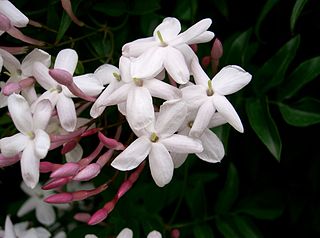
Jasminum polyanthum, the many-flowered jasmine or pink jasmine, is a species of flowering plant in the olive family Oleaceae, native to China and Myanmar. A strong evergreen twining climber, it is especially noted for its abundant, highly fragrant pink to white flowers.

Genista tinctoria, the dyer's greenweed or dyer's broom, is a species of flowering plant in the family Fabaceae. Its other common names include dyer's whin, waxen woad and waxen wood. The Latin specific epithet tinctoria means "used as a dye".
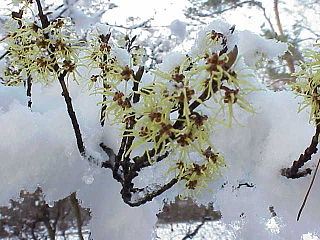
Hamamelis mollis, also known as Chinese witch hazel, is a species of flowering plant in the witch hazel family Hamamelidaceae, native to central and eastern China, in Anhui, Guangxi, Hubei, Hunan, Jiangxi, Sichuan, and Zhejiang.

Genista aetnensis, the Mount Etna broom, is a species of flowering plant in the legume family Fabaceae. It is a large shrub or small tree endemic to Sicily and Sardinia where it is associated with sunny, open landscapes and poor, stony soil. It is a very common constituent of the garigue plant communities, Mediterranean shrubby vegetation, around the lower slopes of Mount Etna, hence its Latin specific epithet aetnensis.

Phlomis fruticosa, the Jerusalem sage, is a species of flowering plant in the sage family Lamiaceae, native to Albania, Cyprus, Greece, Italy, Turkey, and countries of the former Yugoslavia.

Jasminum officinale, known as the common jasmine or simply jasmine, is a species of flowering plant in the olive family Oleaceae. It is native to the Caucasus, northern Iran, Afghanistan, Pakistan, the Himalayas, Tajikistan, India, Nepal and western China. The species is also widely cultivated in many places, and is reportedly naturalized in Spain, France, Italy, Portugal, Romania, Croatia, Bosnia and Herzegovina, Montenegro, Serbia, Algeria, Florida and the West Indies.

Oscularia deltoides, the deltoid-leaved dewplant, dassievygie or sandsteenvygie is a species of flowering succulent plant in the fig-marigold family Aizoaceae that is native to the south-western Cape, South Africa.

Salix acutifolia, also known as Siberian violet-willow, long-leaved violet willow or sharp-leaf willow, is a species of flowering plant in the Salicaceae family, native to Russia and eastern Asia. It is a spreading, deciduous shrub or tree, growing to 10 m (33 ft) tall by 12 m (39 ft) wide. The young shoots are deep purple with a white bloom. The leaves are narrow, up to 10 cm (4 in) long. The catkins are produced in early spring, before the leaves. Older bark has a fine, netted pattern.

Sedum spathulifolium is a species of flowering plant in the family Crassulaceae known by the common names broadleaf stonecrop, yellow stonecrop, and Colorado stonecrop. An evergreen perennial, it is native to western North America from British Columbia to southern California, where it can be found often in the shades in many types of rocky habitat in coastal and inland hills and mountains.

Jasminum angulare, the wild jasmine or angular jasmine, is a species of flowering plant in the family Oleaceae that is indigenous to South Africa.

Azara microphylla, the boxleaf azara, is a species of flowering plant in the willow family Salicaceae, native to Chile and Argentina. Growing to 10 metres (33 ft), it is a small, upright, evergreen tree or large shrub. It has small, shiny, very dark green leaves and tiny, vanilla-scented flowers in winter. It is the hardiest of the azaras, withstanding temperatures down to −15 °C (5 °F), but in cooler temperate regions requires some protection from cold winds. It also tolerates full shade.
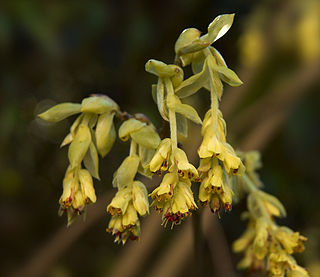
Corylopsis pauciflora, the buttercup witch hazel or winter hazel, is a species of flowering plant in the genus Corylopsis of the family Hamamelidaceae, native to Taiwan and Japan. It is a deciduous, spreading shrub growing to 1.5 m tall by 2.5 m wide. It produces masses of pale yellow flowers in pendent racemes in early spring, followed by leaves opening bronze and turning to rich green. It is cultivated in gardens and parks in temperate regions.
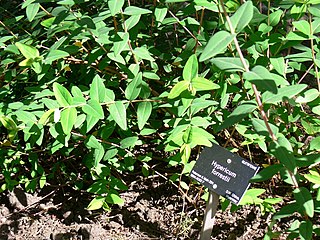
Hypericum forrestii is a species of flowering plant in the family Hypericaceae native to China and Myanmar. It is known as Forrest's tutsan and Forrest's St. John's wort. It was named in honour of the Scottish botanist George Forrest (1873-1932), who was the first westerner to discover it. The species has gained the Royal Horticultural Society's Award of Garden Merit.
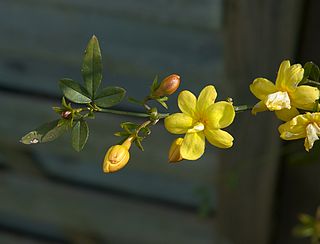
Jasminum mesnyi, the primrose jasmine or Japanese jasmine, is a species of flowering plant in the family Oleaceae, native to Vietnam and southern China. It is also reportedly naturalized in Mexico, Honduras and parts of the southern United States.

Jasminum azoricum, the lemon-scented jasmine, is a species of flowering plant in the olive family. It is an evergreen twining vine native to the Portuguese island of Madeira. The compound leaves consist of 3 bright green leaflets. The fragrant white star-shaped flowers appear in panicles from the leaf axils in summer, evolving from deep pink buds.





















